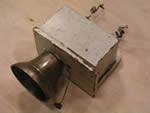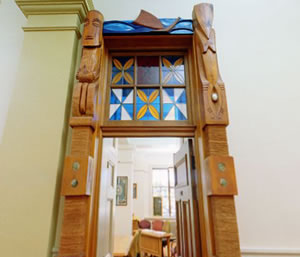House of Representatives: Doing Business
Debating chamber. View as panorama.
The House of Representatives comprises the elected members of Parliament who represent the people of New Zealand. Until 1951, the House of Representatives was also known as the lower house. A political party or parties with the majority of votes in the House form a government, which answers to the House for its policies and actions.
Sittings and sessions
Until 1996 the House needed a quorum of members in the debating chamber for the day's business to begin. Getting a quorum could be a problem in the early years; some MPs did not attend sittings because of travel problems, some left before the session had finished for the year, and others failed to turn up at all.
The House used to start its sessions in the middle of the year to suit the many MPs who were farmers. Sessions lasted two or three months to allow them to get home for Christmas. As the House got busier, sessions got longer, and there would often be a rush of work at the end. The mid-year start continued until 1984 but now Parliament sits through much of the year, with periodic adjournments and sessions that last for the government's full term.
In the 1850s the House began (or sat) at noon three days a week, and ended (or rose) in the evenings. As the business of government grew from the 1860s, the House had to sit later, from early afternoon. When the practice of stonewalling became common, the House would often keep sitting until early the next morning ― 3 a.m. or even later. From 1928 the House rose at 10.30 p.m., but it was not until the late 1930s that sitting beyond midnight largely disappeared.
See 1965 film of MPs being called by the division bells for another sitting.
Saying prayers
Since the House first met in 1854, each sitting day has opened with a prayer. Some of the MPs at that first session of the House thought that a prayer suggested there was a state religion, and others worried about which prayer would be used. In the end, the House accepted that prayers were common in other countries. The Speaker, Charles Clifford, declared that the first clergyman who could be found, whatever his denomination, should be invited into the House to say the opening prayer. Clifford, who was a Roman Catholic, had already arranged for his friend, the Reverend F.J. Lloyd, an Anglican, to be waiting outside the House, and he said the prayer. Since then, the Speaker has said the prayer.
Listen to extract from 'Parliament Opens with a Prayer' radio documentary (307k, mp3). See transcript and related information.
Ayes lobby. View as panorama.
Making decisions
The House makes decisions on motions before it. A formal vote or division into those for and against a motion takes place whenever MPs want to see if the government has majority support, slow down or disrupt proceedings, or record their views.
The traditional system for taking divisions continued until 1996. When division bells were rung, MPs absent from the chamber would have a few minutes to return before the doors were locked; sometimes the keys to the chamber were temporarily 'mislaid' so that latecomers could arrive in time to vote! MPs went into the 'Ayes' and 'Noes' lobbies on either side of the chamber, and had their names ticked off a list. The Speaker would then announce the result and the doors would be unlocked.
Since 1996, MPs have not had to be physically in the chamber to vote because parties can declare their total votes, including the proxy votes of absent members.
The great race
The sound of the bells ringing through Parliament Buildings signals to MPs that it is time to move to the chamber. In the early years a two-minute sand-glass was used to time the interval between ringing the bells and locking the doors of the chamber. A messenger would go round the buildings clanging a large bell or gong to warn members of an impending division. The installation of electric bells in the 1870s put an end to this informal but more personal style of notifying MPs that a division was nigh. After a fire largely destroyed the buildings in 1907, MPs had to walk much further to get to the chamber, and the time was extended to three minutes. In 1979 it was increased to five minutes, a mark set by timing how long it took the oldest messenger available to walk to the chamber from the upper floors of the just-completed Beehive. A similar exercise in 1996 set the allowance at seven minutes.
Some governments had near misses at division time. In 1958 the Labour government only had a majority of one and nearly lost its first division. Labour MP Warren Freer was in the shower and did not hear the division bells. Luckily for the government, an Opposition MP was out of the building, allegedly shopping for toothpaste, and Labour scraped through. From then, Labour used the term 'dirty debate' to warn MPs to stay within earshot.
Organising votes
Did you know?
That the term 'whipping' comes from the English fox hunt?
A whip acts as 'Political Buffalo Bill' in rounding up votes.
MPs known as whips organise members of parties into blocs to vote and speak in debates. The whip's job has been described as 'keeping a House'. They monitor the day's order paper, grant leave from the House, and make sure there is a quorum. Whips act as the eyes and ears of a government, and need a thorough knowledge of what goes on in the chamber. For this reason, they traditionally sit near the front bench.
For much of Parliament's history, whips also organised 'pairs'. 'Pairing' was the informal agreement between MPs on different sides that when one was absent, the other would not vote. This was a way to ensure that the business of the House could be conducted fairly when MPs were away or ill. Whipping and pairing were processes based on trust and cooperation between MPs. Those MPs who unwittingly broke their pairs by being in the chamber had to vote with the other side. Pairing was not officially recognised in the House's standing orders until 1951. It was abolished in 1996, and replaced by the party vote system because the many parties in the House under MMP made the previous system unworkable.
Listen to the poem 'To the Opposition whip' (104k, mp3). Read transcript of this poem.
Pacific Room, used for meetings of select committees. View as panorama.
Select committees
An important part of Parliament's business is done in select committees, which are small groups of MPs who discuss and report on matters referred to them. The House requires committees to hear evidence in public. Committees consider bills and deal with many other things, including petitions presented to the House, finance and expenditure, or how the House works. Since 1979 all bills have been sent to select committee as well.
The select committee structure was overhauled in 1985, and the role of committees was expanded to provide fuller consideration of government policies and expenditure. Under MMP from 1996, select committees have become more important and the government's control of them has weakened. Committee chairs come from different parties, and membership across all the committees is in proportion to the number of MPs in each party.
External links
Learn more about the business of Parliament on the Office of the Clerk website: select committees, the legislative process, government accountability.
The Parliamentary Information Service provides access to submissions presented to select committees.
Next: Parliament: The House - The Opposition >




